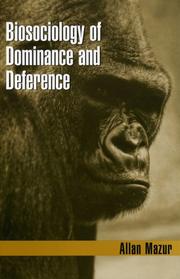| Listing 1 - 5 of 5 |
Sort by
|
Book
ISBN: 0470758554 9780470758557 Year: 1975 Volume: 3 Publisher: Stroudsburg Dowden, Hutchinson and Ross
Abstract | Keywords | Export | Availability | Bookmark
 Loading...
Loading...Choose an application
- Reference Manager
- EndNote
- RefWorks (Direct export to RefWorks)
Ethology --- Social Dominance --- Social hierarchy in animals --- Hiérarchie sociale chez les animaux --- Collected works --- collected works --- Dominance organization in animals --- Hook order --- Peck order --- Peck right hierarchy --- Pecking order --- Rank order (Social hierarchy in animals) --- Animal behavior --- Social behavior in animals --- Animal behavior. --- Social hierarchy in animals. --- Hiérarchie sociale chez les animaux --- Collected works. --- collected works.

ISBN: 0742536920 0742536939 1299782043 0742568601 9780742568600 9780742536937 9780742536920 9780742536920 Year: 2005 Publisher: Lanham
Abstract | Keywords | Export | Availability | Bookmark
 Loading...
Loading...Choose an application
- Reference Manager
- EndNote
- RefWorks (Direct export to RefWorks)
This short, engaging volume develops new and sociologically sophisticated concepts to bring the fields of biology and sociology together. It is about the social biology of face-to-face dominance interactions and explores the evolution of behavior through connections among biology, language, culture, and socialization. Meant to be a self-contained exploration_sociologists would require no prior knowledge of biology; biologists would require no prior knowledge of sociology_this book is a fun, informative supplement for courses throughout sociology and the social sciences.
Dominance (Psychology) --- Psychology, Comparative. --- Social hierarchy in animals. --- Dominance (Psychology). --- Social hierarchy in animals --- Psychology, Comparative --- Social Sciences --- Psychology --- Behavior, Comparative --- Comparative behavior --- Comparative psychology --- Ethology, Comparative --- Intelligence of animals --- Dominance organization in animals --- Hook order --- Peck order --- Peck right hierarchy --- Pecking order --- Rank order (Social hierarchy in animals) --- Social hierarchy (Psychology) --- Zoology --- Animal behavior --- Animal intelligence --- Animal psychology --- Human behavior --- Instinct --- Social behavior in animals --- Control (Psychology) --- Social groups
Book
ISBN: 3805521391 9783805521390 Year: 1975 Volume: 7 Publisher: Basel Karger
Abstract | Keywords | Export | Availability | Bookmark
 Loading...
Loading...Choose an application
- Reference Manager
- EndNote
- RefWorks (Direct export to RefWorks)
Yellow baboon --- Social hierarchy in animals --- Sexual behavior in animals --- Papio --- BEHAVIOR, ANIMAL --- Behavior --- Dominance organization in animals --- Hook order --- Peck order --- Peck right hierarchy --- Pecking order --- Rank order (Social hierarchy in animals) --- Animal behavior --- Social behavior in animals --- Animals --- Breeding behavior --- Copulation behavior in animals --- Copulation in animals --- Copulatory behavior in animals --- Copulatory pattern (Animal behavior) --- Mating behavior --- Reproductive behavior --- Sex behavior in animals --- Sexual behavior --- Yellow baboon - Behavior
Book
ISBN: 331930870X 3319308726 Year: 2016 Publisher: Cham : Springer International Publishing : Imprint: Springer,
Abstract | Keywords | Export | Availability | Bookmark
 Loading...
Loading...Choose an application
- Reference Manager
- EndNote
- RefWorks (Direct export to RefWorks)
This book provides a comprehensive look at nonhuman primate social inequalities as models for health differences associated with socioeconomic status in humans. The benefit of the socially-housed monkey model is that it provides the complexity of hierarchical structure and rank affiliation, i.e. both negative and positive aspects of social status. At the same time, nonhuman primates are more amenable to controlled experiments and more invasive studies that can be used in human beings to examine the effects of low status on brain development, neuroendocrine function, immunity, and eating behavior. Because all of these biological and behavioral substrates form the underpinnings of human illness, and are likely shared among primates, the nonhuman primate model can significantly advance our understanding of the best interventions in humans.
Physiology --- Human Anatomy & Physiology --- Health & Biological Sciences --- Primates --- Social hierarchy in animals. --- Behavior. --- Dominance organization in animals --- Hook order --- Peck order --- Peck right hierarchy --- Pecking order --- Rank order (Social hierarchy in animals) --- Animal behavior --- Social behavior in animals --- Animal physiology. --- Human physiology. --- Psychology, clinical. --- Neurobiology. --- Animal Physiology. --- Social Structure, Social Inequality. --- Human Physiology. --- Health Psychology. --- Neurosciences --- Human biology --- Medical sciences --- Human body --- Animal physiology --- Animals --- Biology --- Anatomy --- Social structure. --- Social inequality. --- Health psychology. --- Health psychology --- Health psychology, Clinical --- Psychology, Clinical health --- Psychology, Health --- Salutogenesis --- Clinical psychology --- Medicine and psychology --- Egalitarianism --- Inequality --- Social equality --- Social inequality --- Political science --- Sociology --- Democracy --- Liberty --- Organization, Social --- Social organization --- Anthropology --- Social institutions --- Equality.
Book
ISBN: 0818500875 Year: 1973 Publisher: Monterey, Ca : Brooks/Cole,
Abstract | Keywords | Export | Availability | Bookmark
 Loading...
Loading...Choose an application
- Reference Manager
- EndNote
- RefWorks (Direct export to RefWorks)
Dominance (Psychology) --- Self-actualization (Psychology) --- Self-evaluation --- Social hierarchy in animals --- Growth, Personal --- Personal growth --- Self-improvement --- Self-realization (Psychology) --- Humanistic psychology --- Mental health --- Motivation (Psychology) --- Social hierarchy (Psychology) --- Control (Psychology) --- Social groups --- Dominance organization in animals --- Hook order --- Peck order --- Peck right hierarchy --- Pecking order --- Rank order (Social hierarchy in animals) --- Animal behavior --- Social behavior in animals --- Self-appraisal --- Self-estimate --- Self-rating --- Self-report --- Evaluation --- Self-perception --- Social comparison --- Dominance (Psychology). --- Self-evaluation. --- Self-actualization (Psychology). --- Social hierarchy in animals. --- Maslow, Abraham Harold,
| Listing 1 - 5 of 5 |
Sort by
|

 Search
Search Feedback
Feedback About
About Help
Help News
News